We’re sharing four of the most dangerous hikes in the U.S., sharing our experiences and why we did them anyway despite the risks. From Zion’s heart-pounding Angel’s Landing and The Narrows to the intense scramble up Mount Storm King in Olympic National Park, we break down the deadly features of each trail. We also tackle the brutal 20-mile trek to Havasupai Falls in the Grand Canyon. Join us as we discuss the thrills, the dangers, and our personal stories from these adrenaline-pumping hikes! Tune in to hear why we still can’t resist the thrill.
If you’re planning to visit these destinations, here are some hotels and other things to do to build out your trip!
- Zion National Park – Stay at the Bumbleberry Inn, consider this highly rated Zion Sunset Jeep tour and if you plan to explore further, download our Utah’s Mighty 5 National Parks Itinerary and listen to our Zion episode to help you plan.
- Olympic National Park – Stay at the Red Lion Hotel Port Angeles Harbor and if you want to see more parks in this beautiful state, download our Washington’s 3 National Parks Itinerary and listen to our episode on Mt. Rainier and Olympic National Parks.
- Havasupai Falls – Stay at the Grand Canyon Caverns Inn and come prepared with Havasupai backpacking essentials and listen to our Havasupai Falls backpacking episode before you go!
- Kauai – Stay at Club Wyndham Bali Hai Villas, explore more fun things to do in Kauai in our curated Viator Shop, and download our one week Kauai itinerary to easily follow a fully planned out trip!
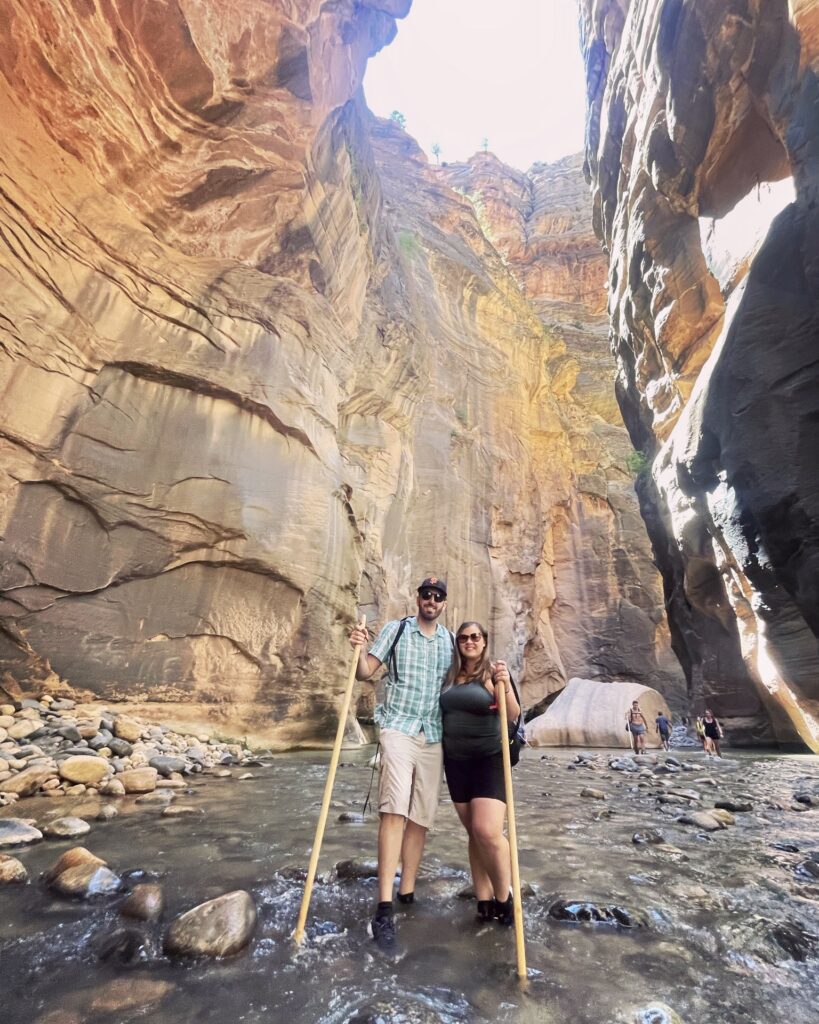
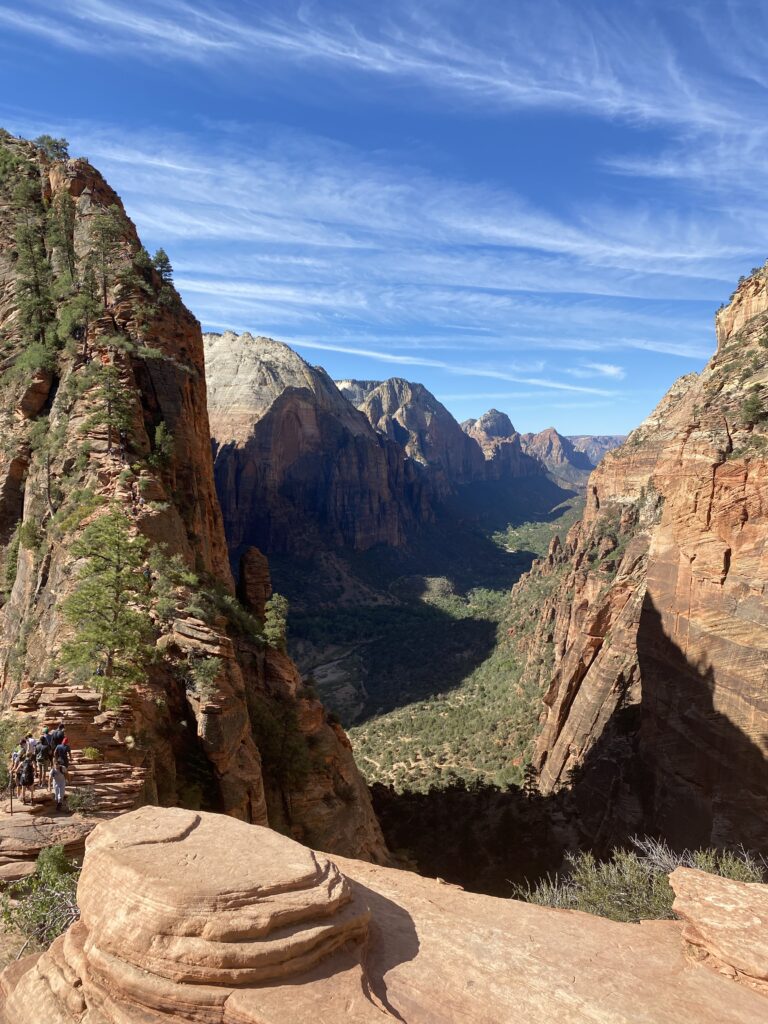
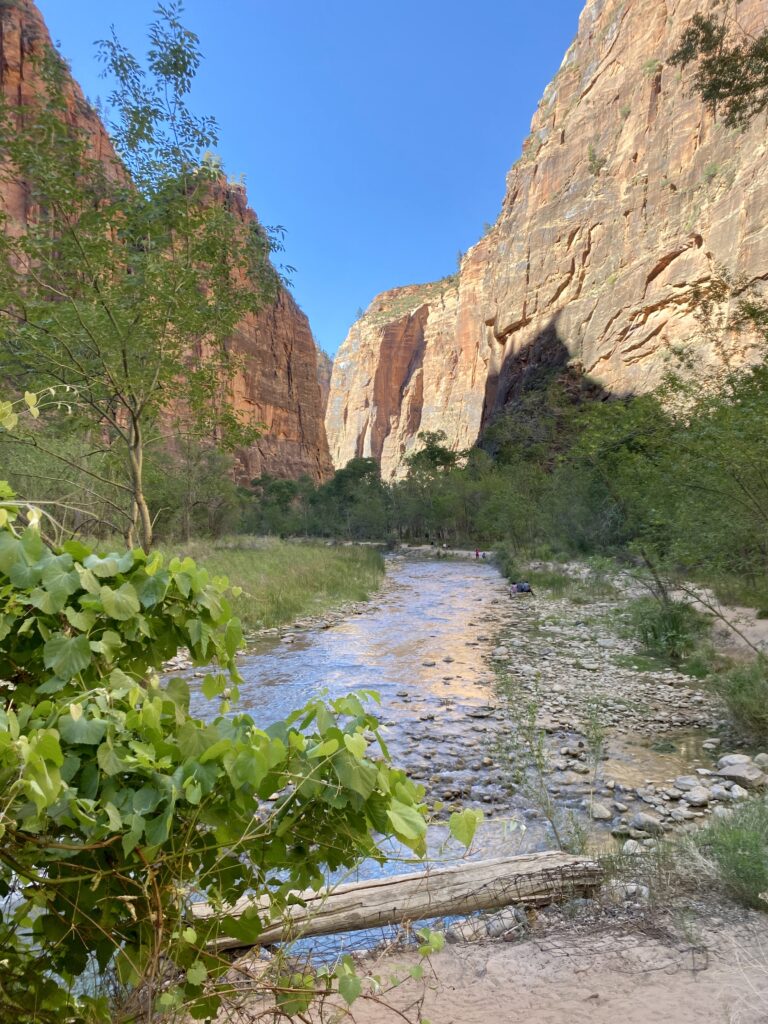
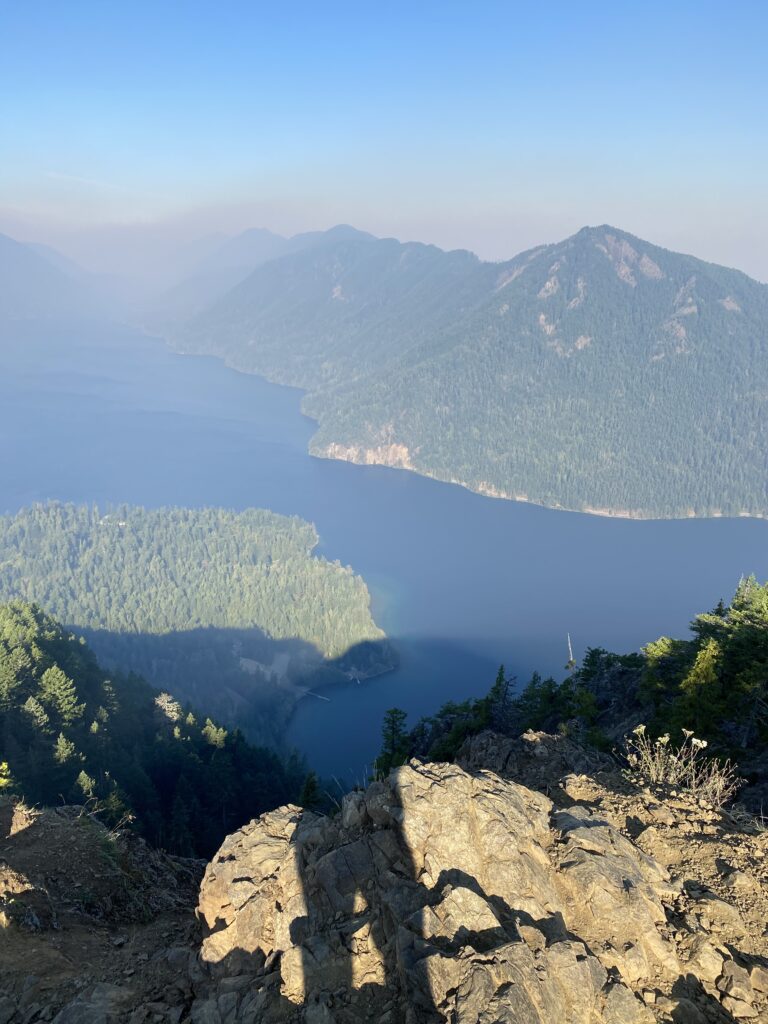
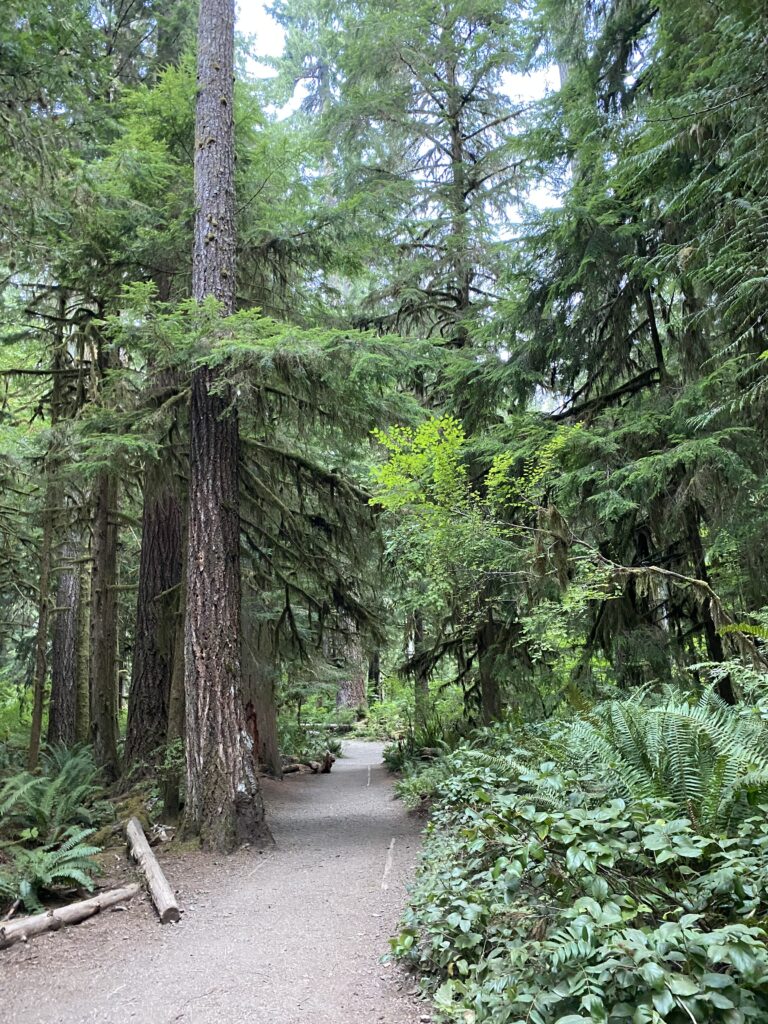
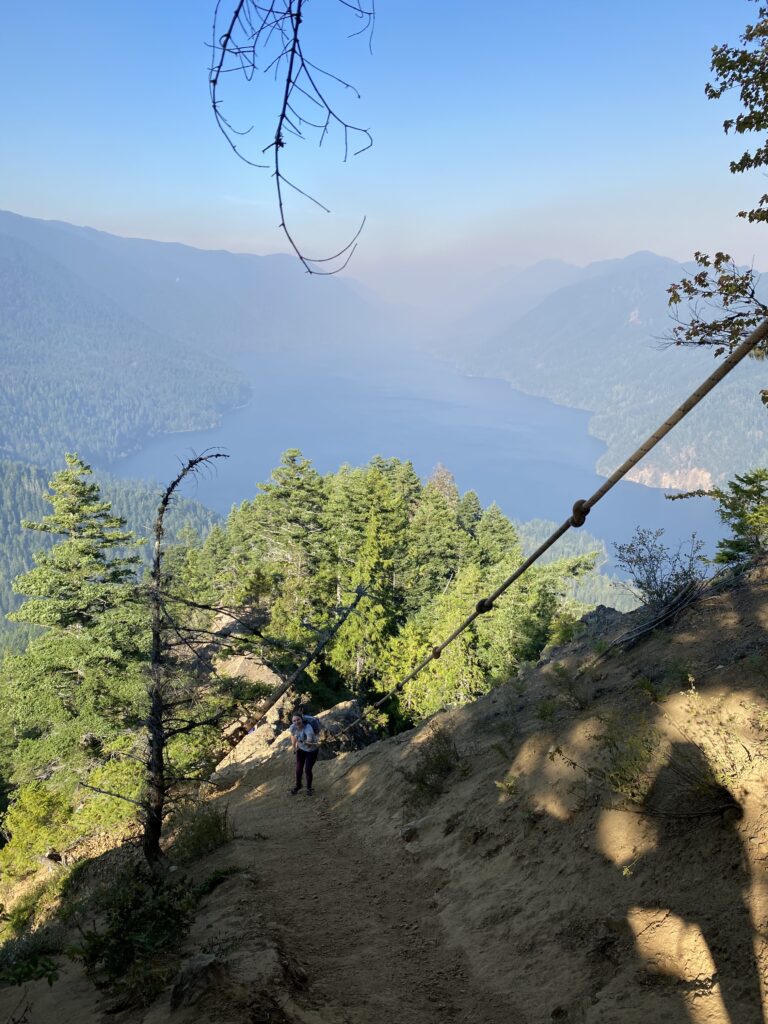
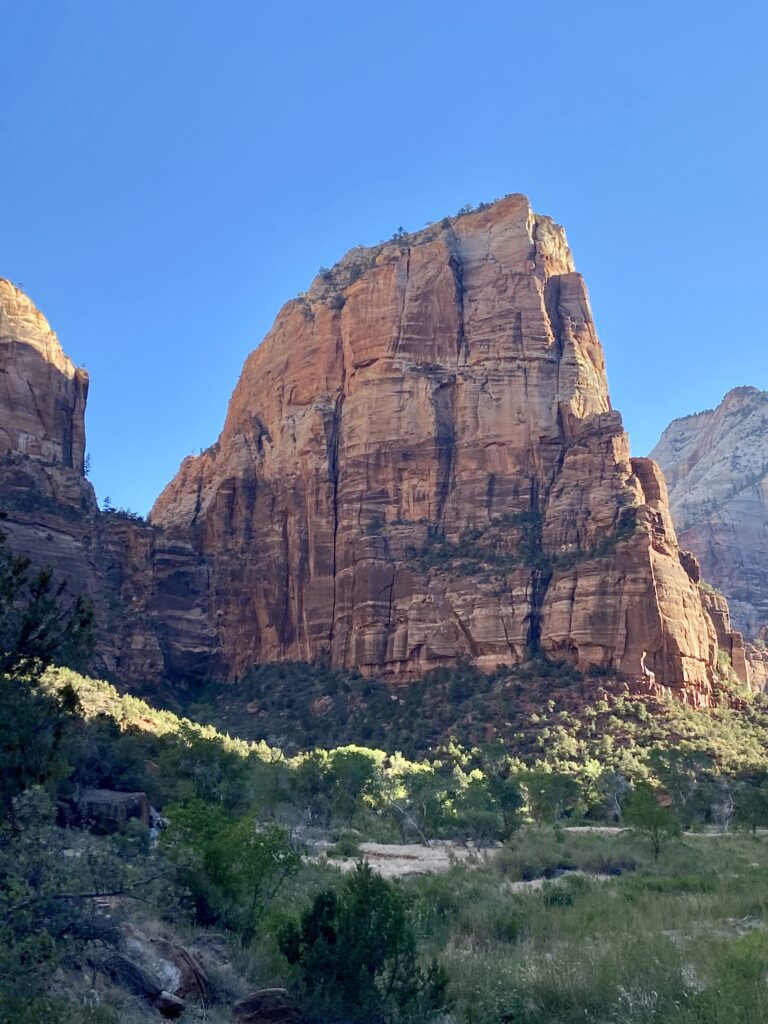
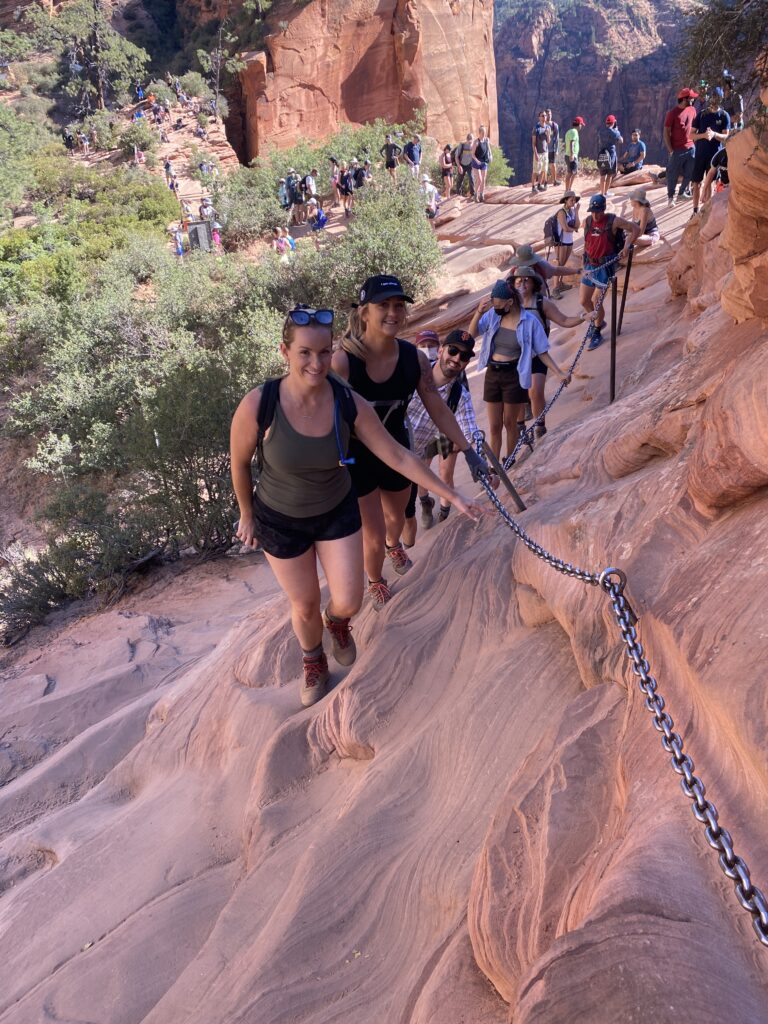

Find a flight deal by signing up for Thrifty Traveler Premium and watching the daily flight deals (points & cash) that are emailed directly to you! Use our promo code TS10 to get $10 off your first year subscription.
Deadly Hikes – Episode Transcript
0:51
Today we’re sharing with you 4 very popular hikes that you can actually die on.
I know, very morbid, right?
But four hikes that are deadly that we have actually done.
Super excited to talk about this.
We’ve actually not ever died on these because we’re here to talk about it.
1:09
Almost died.
But we’re going to get right into it.
So what we’re going to talk about first is 1 National Park that has two deadly hikes, and that is Zion National Park.
We’re going to start with Angels Landing.
And Angels Landing is one of the most famous and most thrilling of the hikes in Zion National Park.
1:29
It has a ton of steep drop offs, A narrow ridgeline and some epic views.
And it’s deadly because there’s a chain section of this hike.
Like the last half mile or quarter mile?
1:44
Yeah, you can do most of this hike without risk of death.
The switchbacks might kill you for other reasons.
Physically, but not actually.
I’ve never done the chain part because I don’t want to die and it does feel like you’re going to die when you’re going up them.
2:01
You’ve attempted it twice, once where it was snowing outside with us and we just decided it was too slippery, too dangerous.
And that was a good call.
Yeah, well, even in the snow, I wasn’t ready to do it that time either.
We had done it before Brittany and I brought you this time, too snowy.
2:18
Then we veered off and went another way.
But we came back another time, in spring or summer.
Summer.
And then Brittany and I ventured on and continued.
Because you attempted to start the chains but just couldn’t.
I said hell no.
You got you are a little bit of the chains.
2:33
I have seen videos and once you get past that deadly part, it gets a little less deadly.
But there’s also there were people coming both directions.
So if someone flies down on their way to death, they’re taking you down with them.
Yeah.
And so when we say chains, that’s not like, oh, this is just helping you pull up.
2:50
You have the chains because to the right, to the left, no exaggeration, sheer 1000 foot drops.
And again, I’m not even exaggerating with that number of 1000.
So now though, when we went, they did not have the permitted system.
They have a permit now, which means there’s less people on it.
3:07
So you have less of that cross traffic or potential for things to happen based off of an accident or somebody bumping into you versus your own mistake.
But when we say this is dead, it’s not like, oh, you just, you can fall off and die.
Literally since the year 2000, there have been 13 deaths on this hike, specifically on the chains of people falling over.
3:28
So we’re in the year 2025 right now.
If you take that average, that’s one every two years.
So yes, thousands of people do it a year, but lots of people die.
Do you want to be the one?
It can happen.
Somebody, I hate to say this, somebody was.
Well, Jamal and I have actually hiked this successfully at least three times that we.
3:48
Really testing your odds.
I know, I guess so, but.
We love this hike so.
Much, Yeah.
It’s a great hike.
Like when you really get to the end, it’s such a good view of Zion.
It’s it’s amazing.
Like there are some pictures.
No better views really.
The hike itself all the way is like 5.4 miles round trip and you do have 1500 feet of elevation gain But again like Kim said most of that is safe so if you guys want to try it go for it but just be cautious.
4:18
The scariest part for me is when people are on the chains at the same time, because it’s not like you’re on just one chain by yourself.
If someone’s pulling or tugging and it throws off your balance, that’s what gets me.
Like that’s what I have.
Heard October first thing in the morning.
4:33
There’s a lot less people.
You might even have it to yourself.
So if you want to lower your chances of dying at Angel’s Landing, go in October.
We’re bringing you in October, Cam, so you’re gonna do it.
We’ll talk about.
That that’s a no for her.
Well Brittany had mentioned two were in Zion National Park.
4:50
The next one is the narrows.
I want to say we did this as a squad.
We did Kim, you successfully completed it but completion even for us, that’s subjective right?
Because this hike can be as long as 16 miles round trip.
You really get to choose how far you go.
5:06
But what the narrows is is hiking and wading through whether it depends on the water level at that point in time.
It could be ankle to you need to even waist high wading through the Virgin River and you just have sheer 1000 foot cliffs to the side of you.
5:23
Of course you’re not going to fall off of those.
You are actually in the river.
But why this is deadly is it’s very known to have lots of flash floods.
It doesn’t even need to be raining in the park.
It could rain 30 miles away.
And if it does, a flash flood is coming and people die all the time because flash floods come and sweep people away through here.
5:45
Beautiful hike, but deadly.
Yeah, there’s also a lot of temperature changes in the Canyon because you’re kind of shielded from the sun because you’re at the very bottom of the river and these sheer 1000 foot cliffs are right above you.
And it’s called the Narrows because the in a section of the Canyon is like 20 to 30 feet.
6:07
So not only can you die from flash floods, you could also die from hypothermia because the water is pretty cold.
And if you’re not dressed appropriately or the weather changes quickly, you can actually die from hypothermia depending on how high the water level is too.
Because there were parts where I think I was like almost chest deep in this water.
6:26
Right.
We were there in August, so it’s very hot outside.
June.
We were there in June.
June still very hot the water mostly was shin but it did get really high at some points were short so even waist I would say some parts my feet were cold.
6:43
Yeah, it definitely the higher time.
Well, you stay in the water that long, of course it’s gonna get cold, you know, And then if it gets all pruney and then.
But you could also die from heat related illness and there’s too.
So it’s like flash floods, heat related hypothermia, drinking.
Water because you’re in water, so you you don’t think you’re as dehydrated as you are.
7:03
Or drowning, yeah.
Yeah, they actually do close the the narrows when the water level goes like a certain amount of like a cubic feet per second.
So if it’s like over 150 cubic feet per second, they actually close the hike down.
7:21
But if you’re like in the cross of it and it starts to pick up while you’re already in it, you might not know that.
Something that I read online too of some of the deaths is even though you’re in the river and of course you have the sheer Canyon cliffs to the side of you, so it’s up, there are boulders to the side that people climb and they’ll fall off of the boulders doing that because it’s wet, it’s slippery.
7:42
And this hike is equally as deadly as Angel’s Landing.
When I googled it, it also said since the year 2013 deaths.
So again, you’re averaging one every two years.
One of the more recent deaths I heard was not for a human, but at some point the water wasn’t flowing fast enough and it some sort of algae bloom and a dog, a dog with them drank the water or had a cut, got infected and passed away.
8:08
So I mean, that could possibly even happen to a human.
Not that you’d be drinking it, but if you have a cut, any sort of bacteria or anything in the water can get in you.
But I mean, that’s anywhere, no doubt.
But realistically, flash floods are really what’s going to do.
It any of these like big slot canyons, flash floods are a huge risk in this area, especially in OH.
8:30
I can see it just getting washed away unfortunately, so be careful.
The third deadly hike that we have also done is Mount Storm King at Olympic National Park.
This is a pretty brutal hike.
8:45
You’re ascending to a top of a peak, but it is the very top part that is really what is scary, dangerous, windy, and of course, who wants to do it?
I do this one, why not?
To do it well, you know, it starts nice and mellow hiking through the forest.
Then you have a steep climb.
9:01
No doubt you do.
You can fall as you’re climbing there, but it is a really well paved trail at that point.
But at some point then once you get closer to the top, the trail starts to narrow.
It becomes more rocky and you get to a point where you’ll actually see a sign where it says that the trail is no longer maintained by the National Park Service.
9:22
It’s done.
Don’t continue.
You’re on your own.
But what a tease.
Why would they end it before you get to the summit?
Because the summit’s just right there.
So people who have that same mindset have said, well, if the National Park is not going to maintain it, I’m going to tie a rope and a chain and we’re just going to climb up this sheer rock face over here.
9:39
Oh, and by the way, once you get to the top, there’s another 20 feet that you kind of got a boulder and scramble up to get really the best views.
So we all made it to the point of the rope.
Kim I I respect the fact that you don’t want to die.
9:55
You stopped at the rope and waited.
Yeah, it was me and Leah’s son who was like 9 years old at the time, and it was really windy this day too, and it’s literally the side of a Cliff with this much Cliff, this much straight fall.
And me and the kid are and Zaina actually.
10:13
We’re all like.
Just about to cry and and we go back.
Yeah, there were six of us, so the three of them opt out immediately.
Jim, I start climbing with the rope and I’m determined.
So Jamal’s like, well, I guess I have to go behind her.
By the way, there’s a great photo, one of the best candid photos I have.
10:31
I think me climbing the rope fairness, I wasn’t looking at it, but I have a good posture and physique in that rope climb.
We’ll have to post it.
I love that photo myself.
Look good in.
It And then Leah came behind us and she’s the real MVP because she did this in like hiking sandals.
10:47
Yeah, and she’s like, this is nothing.
Yeah, so we make it up the rope section and then Jamal talked about there’s that last little scramble to the very top, and Jamal chickened out like halfway up.
But Leah and I, we made it to the top and out of the six, only Leah and I made it to the views of Lake Crescent.
11:05
So.
One, when you’re climbing that rope, keep in mind you don’t know how sturdy the person who put it there tied it for you.
Who’s decided to move, move it for whatever reason?
Is it so?
Yeah, Yeah.
You’re really taking that risk because, again, it’s not even maintained by the National Park.
And then when that’s that last little boulder section, I really wanted to go up.
11:22
I’m crawling on my hands and knees, quite literally, because that’s the only way you can do it.
But it is so windy to the right, to the left, there’s a way that you can fall.
And it wasn’t getting up That was the problem.
As I was climbing, I realized, shit, I don’t know how I’m gonna get down on my butt or traverse my way down this.
11:40
So I was just like, you know what?
I’m literally, I’m 10 feet from the top.
I lost it.
I didn’t do it.
I turned back around.
But Brittany and Lee, well, you don’t believe it.
I mean, it was 10 feet.
From the no, I don’t blame.
You don’t blame, I don’t believe.
It I wouldn’t have done it.
11:56
But they made it.
They did, yeah.
So there’s no official tally on deaths, but they do believe at least 14 deaths have happened between 2014 and 2019.
So in that five years, yeah, Yeah.
12:11
I don’t like those odds.
And I think it’s very telling when a National Park won’t give you an actual stat.
Of course.
I mean, they know when deaths happened in the park, but why are they not attributing it to this?
Oh, there’s no official, but they know what happened, right?
So.
Sketch.
Yep, Yep, Yep.
12:27
It’s worth it.
It’s only 4.1 miles round trip, 2000 feet of elevation gain and good views of Lake Crescent when there aren’t wildflower fires going on.
And there’s beautiful views in a lot of parts.
Until you get to that no longer maintain sign the the safe parts so you can still get views without risking your life.
12:49
Yeah, up until you get to that point.
Beautiful hike too.
Did we mention that this is an Olympic National Park?
We did OK, just wanted to make sure. 8 National Park and Zion’s a great National Park too.
I think all of these national parks are great.
So the last deadly hike we’re going to talk about is adjacent to Grand Canyon National Park in its Havasupai Falls.
13:09
Kim and I hike this of March 2024.
It’s a 10 mile hike to get to the campground where you’re going to backpack, and it’s a four day, three night reservation.
The 10 mile hike alone will nearly kill you with your backpack on.
13:26
And I didn’t hike the way out.
I took the helicopter, but that definitely would have killed me.
It would have killed you.
But people die all the time from heat exhaustion because it’s in Arizona, in the Grand Canyon, but on an Indian part of Indian Reservation, part of the Grand Canyon, it’s very, very hot.
13:43
Yeah, I mean, there’s definitely pros and cons of going in March.
We the water wasn’t really warm enough to swim in, but it was definitely more tolerable heat wise.
I can’t imagine going in summer and having a hike, you know, in and out in the heat.
13:58
So if you are going to hike it, start early because you’re going to beat the heat that way.
When you are hiking into Havasupai Falls, it’s all pretty much downhill because you start at the very top and you hike your way into the Canyon and it is very very steep and it’s a long hike.
14:16
Especially like you might say 10 miles isn’t long. 10 miles with 35 lbs on your back is long and hard.
I ended up ditching Kim at some point.
I was with so like die on my own.
No, you had someone with you.
Don’t be dramatic for a.
Lot of it.
14:32
And then so her, her cousin and I continued on and Kim like she said she took the helicopter out cuz she thought she would die on the way out.
But her cousin Savannah and I hiked up and it was a brutal hike up, so definitely hard and you could possibly die on it.
14:50
There was a very recent tragic moment at Havasupai Falls in August 2024.
There were some major was it flash floods that came through and the turquoise blue waterfalls turn brown from how much during mud was flying through and it just washed away people.
15:09
And someone did die, yeah.
And then?
Find them for a long time.
Very tragic, very sad.
Yeah.
But the Grand Canyon as a whole is pretty deadly.
There was been 17 deaths per year from 2007 to 2024.
15:25
Yeah, that’s the average.
And so again, Havasupai Falls is not officially in Grand Canyon National Park.
It is adjacent, as can mentioned, in native land, but that’s why we’re saying just kind of Grand Canyon as a whole, because truly these deaths come from hiking heat exposure, which you are in the elements here when you’re at Havasu.
15:47
And because it is on native land, they have their own record keeping, but they don’t necessarily release it.
So there’s not official tallies of how many people have passed, but just generally being in that area, very, very deadly region, especially if you’re taking that much weight on your back that long, you’re gonna encounter potential problems.
16:05
And of course, most recent tragic, of course the flash floods, but things can happen on.
This and not to mention death, but injuries, illness that happens all the time on this.
Kim was injured on this hike.
My knees were messed up for months.
People got really sick right after we were.
16:21
There, Yeah, something with the water.
There was something going on with the water and tons of people just got like a stomach bug and yeah, I know we’re not doing well.
Selling it very well, but it truly was one of the best hiking experiences I’ve ever had.
There’s a full episode on that for your ladies backpack and trip.
16:38
You guys should go listen to it because you really do hype it up.
But this episode, of course, we’re just talking about hikes that we’ve done that are known to be deadly and dangerous.
Again, go with your own comfort factor on and what you’re willing to do.
But nevertheless, you can see lots of people come out alive.
16:54
But it can happen, so it’s good to know before you do it.
Roll the dice and test your luck.
And thanks so much for tuning into this week’s Just the Tip.
Comments
Comments Off on Hikes You Can Die On & Why We Did Them Anyway